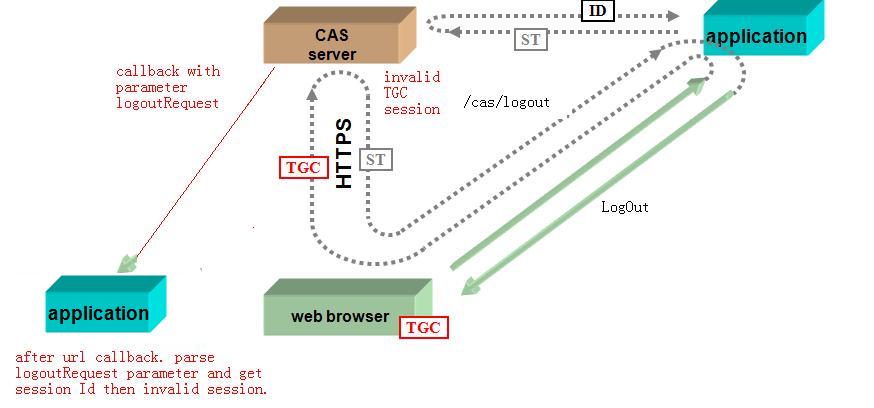声明:本博客属作者原创,如果任何网站转载本文,请注明作者及引用来源,谢谢合作!
关于Cas实现单点登入(single sing on)功能的文章在网上介绍的比较多,想必大家多多少少都已经有所了解,在此就不再做具体介绍。如果不清楚的,那只能等我把single sign on这块整理出来后再了解了。当然去cas官方网站也是有很多的文章进行介绍。cas官网
http://www.ja-sig.org/products/cas/。
ok,现在开始本文的重点内容讲解,先来了解一下cas 实现single sign out的原理,如图所示:

图一

图二
第一张图演示了单点登陆的工作原理。
第二张图演示了单点登出的工作原理。
从第一张图中,当一个web浏览器登录到应用服务器时,应用服务器(application)会检测用户的session,如果没有session,则应用服务器会把url跳转到CAS server上,要求用户登录,用户登录成功后,CAS server会记请求的application的url和该用户的sessionId(在应用服务器跳转url时,通过参数传给CAS server)。此时在CAS服务器会种下TGC Cookie值到webbrowser.拥有该TGC Cookie的webbrowser可以无需登录进入所有建立sso服务的应用服务器application。
在第二张图中,当一个web浏览器要求登退应用服务器,应用服务器(application)会把url跳转到CAS server上的 /cas/logout url资源上,
CAS server接受请求后,会检测用户的TCG Cookie,把对应的session清除,同时会找到所有通过该TGC sso登录的应用服务器URL提交请求,所有的回调请求中,包含一个参数logoutRequest,内容格式如下:
<samlp:LogoutRequest ID="[RANDOM ID]" Version="2.0" IssueInstant="[CURRENT DATE/TIME]">
<saml:NameID>@NOT_USED@</saml:NameID>
<samlp:SessionIndex>[SESSION IDENTIFIER]</samlp:SessionIndex>
</samlp:LogoutRequest>
所有收到请求的应用服务器application会解析这个参数,取得sessionId,根据这个Id取得session后,把session删除。
这样就实现单点登录的功能。
知道原理后,下面是结合源代码来讲述一下内部的代码怎么实现的。
首先,要实现single sign out在 应用服务器application端的web.xml要加入以下配置
<filter>
<filter-name>CAS Single Sign Out Filter</filter-name>
<filter-class>org.jasig.cas.client.session.SingleSignOutFilter</filter-class>
</filter>
<filter-mapping>
<filter-name>CAS Single Sign Out Filter</filter-name>
<url-pattern>/*</url-pattern>
</filter-mapping>
<listener>
<listener-class>org.jasig.cas.client.session.SingleSignOutHttpSessionListener</listener-class>
</listener>
注:如果有配置CAS client Filter,则CAS Single Sign Out Filter 必须要放到CAS client Filter之前。
配置部分的目的是在CAS server回调所有的application进行单点登出操作的时候,需要这个filter来实现session清楚。
主要代码如下:
org.jasig.cas.client.session.SingleSignOutFilter
1 public void doFilter(final ServletRequest servletRequest, final ServletResponse servletResponse, final FilterChain
2
3 filterChain) throws IOException, ServletException {
4 final HttpServletRequest request = (HttpServletRequest) servletRequest;
5
6 if ("POST".equals(request.getMethod())) {
7 final String logoutRequest = request.getParameter("logoutRequest");
8
9 if (CommonUtils.isNotBlank(logoutRequest)) {
10
11 if (log.isTraceEnabled()) {
12 log.trace ("Logout request=[" + logoutRequest + "]");
13 }
14 //从xml中解析 SessionIndex key值
15 final String sessionIdentifier = XmlUtils.getTextForElement(logoutRequest, "SessionIndex");
16
17 if (CommonUtils.isNotBlank(sessionIdentifier)) {
18 //根据sessionId取得session对象
19 final HttpSession session = SESSION_MAPPING_STORAGE.removeSessionByMappingId(sessionIdentifier);
20
21 if (session != null) {
22 String sessionID = session.getId();
23
24 if (log.isDebugEnabled()) {
25 log.debug ("Invalidating session [" + sessionID + "] for ST [" + sessionIdentifier + "]");
26 }
27
28 try {
29 //让session失效
30 session.invalidate();
31 } catch (final IllegalStateException e) {
32 log.debug(e,e);
33 }
34 }
35 return;
36 }
37 }
38 } else {//get方式 表示登录,把session对象放到SESSION_MAPPING_STORAGE(map对象中)
39 final String artifact = request.getParameter(this.artifactParameterName);
40 final HttpSession session = request.getSession();
41
42 if (log.isDebugEnabled() && session != null) {
43 log.debug("Storing session identifier for " + session.getId());
44 }
45 if (CommonUtils.isNotBlank(artifact)) {
46 SESSION_MAPPING_STORAGE.addSessionById(artifact, session);
47 }
48 }
49
50 filterChain.doFilter(servletRequest, servletResponse);
51 }
SingleSignOutHttpSessionListener实现了javax.servlet.http.HttpSessionListener接口,用于监听session销毁事件
1 public final class SingleSignOutHttpSessionListener implements HttpSessionListener {
2
3 private Log log = LogFactory.getLog(getClass());
4
5 private SessionMappingStorage SESSION_MAPPING_STORAGE;
6
7 public void sessionCreated(final HttpSessionEvent event) {
8 // nothing to do at the moment
9 }
10
11 //session销毁时
12 public void sessionDestroyed(final HttpSessionEvent event) {
13 if (SESSION_MAPPING_STORAGE == null) {//如果为空,创建一个sessionMappingStorage 对象
14 SESSION_MAPPING_STORAGE = getSessionMappingStorage();
15 }
16 final HttpSession session = event.getSession();//取得当然要销毁的session对象
17
18 if (log.isDebugEnabled()) {
19 log.debug("Removing HttpSession: " + session.getId());
20 }
21 //从SESSION_MAPPING_STORAGE map根据sessionId移去session对象
22 SESSION_MAPPING_STORAGE.removeBySessionById(session.getId());
23 }
24
25 /**
26 * Obtains a {@link SessionMappingStorage} object. Assumes this method will always return the same
27 * instance of the object. It assumes this because it generally lazily calls the method.
28 *
29 * @return the SessionMappingStorage
30 */
31 protected static SessionMappingStorage getSessionMappingStorage() {
32 return SingleSignOutFilter.getSessionMappingStorage();
33 }
34 }
接下来,我们来看一下CAS server端回调是怎么实现的
先来看一下配置,我们知道CAS server所有的用户登录,登出操作,都是由CentralAuthenticationServiceImpl对象来管理。
我们就先把到CentralAuthenticationServiceImpl的spring配置,在applicationContext.xml文件中
<!-- CentralAuthenticationService -->
<bean id="centralAuthenticationService" class="org.jasig.cas.CentralAuthenticationServiceImpl"
p:ticketGrantingTicketExpirationPolicy-ref="grantingTicketExpirationPolicy"
p:serviceTicketExpirationPolicy-ref="serviceTicketExpirationPolicy"
p:authenticationManager-ref="authenticationManager"
p:ticketGrantingTicketUniqueTicketIdGenerator-ref="ticketGrantingTicketUniqueIdGenerator"
p:ticketRegistry-ref="ticketRegistry"
p:servicesManager-ref="servicesManager"
p:persistentIdGenerator-ref="persistentIdGenerator"
p:uniqueTicketIdGeneratorsForService-ref="uniqueIdGeneratorsMap" />
配置使用了spring2.0的xsd。CentralAuthenticationServiceImpl有一个属性叫uniqueTicketIdGeneratorsForService,它是一个map对象
它的key值是所有实现org.jasig.cas.authentication.principal.Service接口的类名,用于保存Principal对象和进行单点登出回调
application server时使用 value值为org.jasig.cas.util.DefaultUniqueTicketIdGenerator对象,用于生成唯一的TGC ticket。
该属性引用的uniqueIdGeneratorsMap bean在uniqueIdGenerators.xml配置文件中。
<util:map id="uniqueIdGeneratorsMap">
<entry
key="org.jasig.cas.authentication.principal.SimpleWebApplicationServiceImpl"
value-ref="serviceTicketUniqueIdGenerator" />
<entry
key="org.jasig.cas.support.openid.authentication.principal.OpenIdService"
value-ref="serviceTicketUniqueIdGenerator" />
<entry
key="org.jasig.cas.authentication.principal.SamlService"
value-ref="samlServiceTicketUniqueIdGenerator" />
<entry
key="org.jasig.cas.authentication.principal.GoogleAccountsService"
value-ref="serviceTicketUniqueIdGenerator" />
</util:map>
那CentralAuthenticationServiceImpl是怎么调用的呢?
我们跟踪一下代码,在创建ticket的方法 public String createTicketGrantingTicket(final Credentials credentials)中
可以找到以下这样一段代码:
1 //创建 TicketGrantingTicketImpl 实例
2 final TicketGrantingTicket ticketGrantingTicket = new TicketGrantingTicketImpl(
3 this.ticketGrantingTicketUniqueTicketIdGenerator
4 .getNewTicketId(TicketGrantingTicket.PREFIX),
5 authentication, this.ticketGrantingTicketExpirationPolicy);
6 //并把该对象保存到 ticketRegistry中
7 this.ticketRegistry.addTicket(ticketGrantingTicket);
上面的代码,看到ticketRegistry对象保存了创建的TicketGrantingTicketImpl对象,下面我们看一下当ticket销毁的时候,会做什么
事情,代码如下:
1 public void destroyTicketGrantingTicket(final String ticketGrantingTicketId) {
2 Assert.notNull(ticketGrantingTicketId);
3
4 if (log.isDebugEnabled()) {
5 log.debug("Removing ticket [" + ticketGrantingTicketId
6 + "] from registry.");
7 }
8 //从 ticketRegistry对象中,取得TicketGrantingTicket对象
9 final TicketGrantingTicket ticket = (TicketGrantingTicket) this.ticketRegistry
10 .getTicket(ticketGrantingTicketId, TicketGrantingTicket.class);
11
12 if (ticket == null) {
13 return;
14 }
15
16 if (log.isDebugEnabled()) {
17 log.debug("Ticket found. Expiring and then deleting.");
18 }
19 ticket.expire();//调用expire()方法,让ticket过期失效
20 this.ticketRegistry.deleteTicket(ticketGrantingTicketId);//从ticketRegistry中删除的ticket 对象
21 }
我们看到,它是从
ticketRegistry对象中取得TicketGrantingTicket对象后,调用expire方法。接下来,要关心的就是expire方法做什么事情
1 public synchronized void expire() {
2 this.expired.set(true);
3 logOutOfServices();
4 }
5
6 private void logOutOfServices() {
7 for (final Entry<String, Service> entry : this.services.entrySet()) {
8 entry.getValue().logOutOfService(entry.getKey());
9 }
10 }
从代码可以看到,它是遍历每个 Service对象,并执行logOutOfService方法,参数是String sessionIdentifier
现在我们可以对应中,它存放的Service就是在
uniqueIdGeneratorsMap bean定义中的那些实现类
因为logOutOfService方法的实现,所有实现类都是由它们继承的抽象类AbstractWebApplicationService来实现,我们来看一下
AbstractWebApplicationService的logOutOfService方法,就可以最终找出,实现single sign out的真正实现代码,下面是主要代码片段:
1 public synchronized boolean logOutOfService(final String sessionIdentifier) {
2 if (this.loggedOutAlready) {
3 return true;
4 }
5
6 LOG.debug("Sending logout request for: " + getId());
7 //组装 logoutRequest参数内容
8 final String logoutRequest = "<samlp:LogoutRequest xmlns:samlp=\"urn:oasis:names:tc:SAML:2.0:protocol\" ID=\""
9 + GENERATOR.getNewTicketId("LR")
10 + "\" Version=\"2.0\" IssueInstant=\"" + SamlUtils.getCurrentDateAndTime()
11 + "\"><saml:NameID
12
13 xmlns:saml=\"urn:oasis:names:tc:SAML:2.0:assertion\">@NOT_USED@</saml:NameID><samlp:SessionIndex>"
14 + sessionIdentifier + "</samlp:SessionIndex></samlp:LogoutRequest>";
15
16 this.loggedOutAlready = true;
17 //回调所有的application,getOriginalUrl()是取得回调的application url
18 if (this.httpClient != null) {
19 return this.httpClient.sendMessageToEndPoint(getOriginalUrl(), logoutRequest);
20 }
21
22 return false;
23 }
至此,已经通过源代码把 CAS实现 single sign out的实现原理和方法完整叙述了一遍,希望对CAS感兴趣的朋友有所帮忙,
如果有什么问题也希望大家提出和指正。
Good Luck!
Yours Matthew!